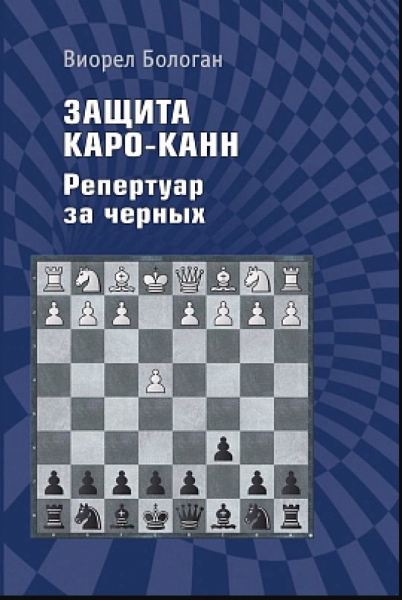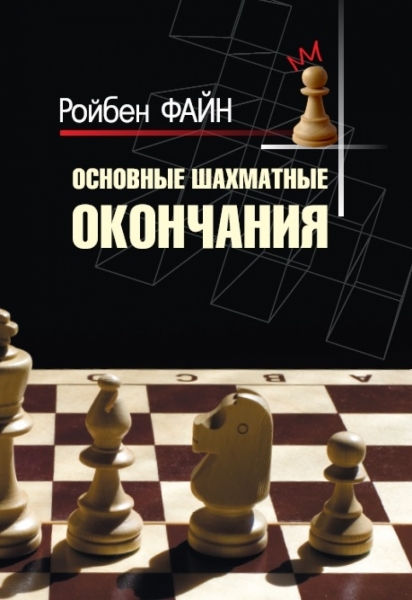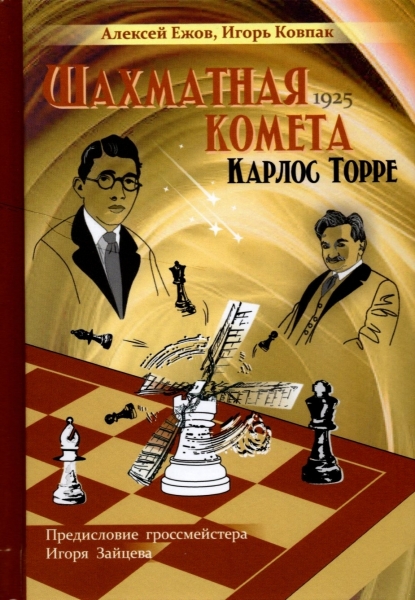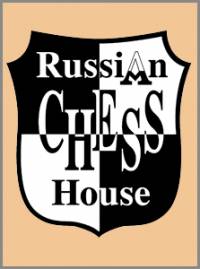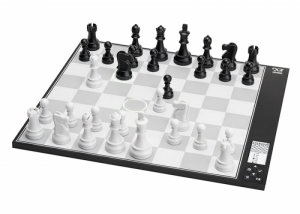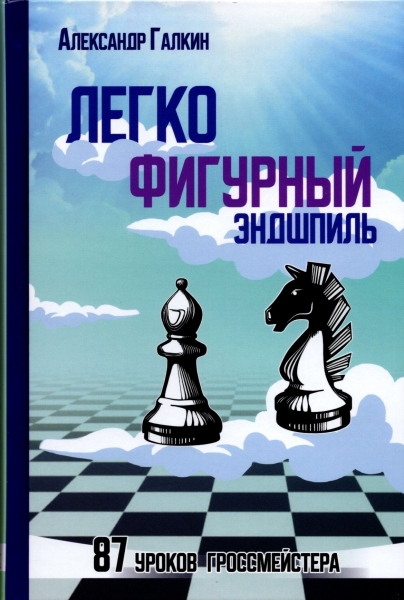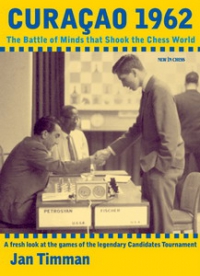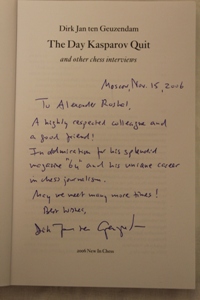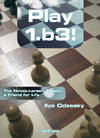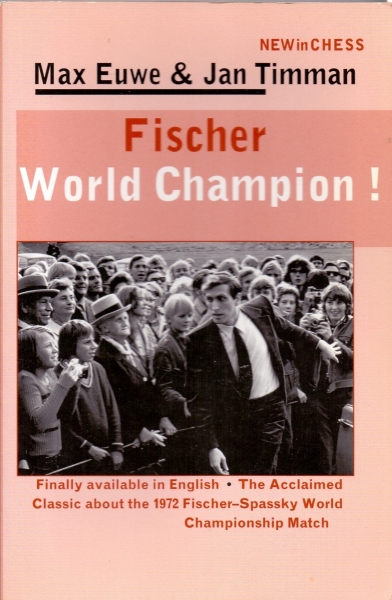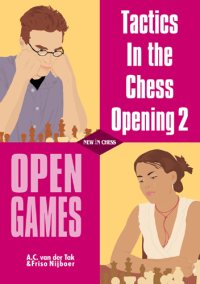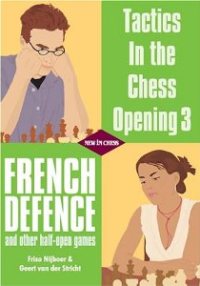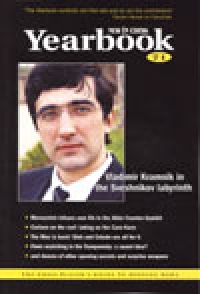New In Chess
Книги издательства:
- Сортировка:
- от дорогих
- от дешевых
- новые поступления
- названия
- автор
-
The 1962 Candidates’ Tournament in Curaзao was one of the fiercest chess battles of all time. At the height of the Cold War, eight players contested the right to challenge World Champion Mikhail Botvinnik. The format of the tournament was a gruelling quadruple round-robin. Twenty-eight games were to be played on the tropical island, in a contest that lasted two months. The air trembled with drama and intrigue. One of the favourites, the brilliant Mikhail Tal,was taken to hospital after 21 rounds and had to withdraw. Three other players from the Soviet Union, Keres, Petrosian, and Geller, were making suspiciously short draws when playing each other. The two American players came to blows over the services of the second they were supposed to share. Bella Kortchnoi, whose husband took an early lead in the tournament, was a puppet in the hands of the scheming Rona Petrosian, the wife of the later winner. And one of the favourites was a lanky 19-year-old boy from Brooklyn, Bobby Fischer, who openly accused the Soviets of collusion and was later proven right. In the end, Tigran Petrosian was the winner and went on to become the new World Champion the following year. But such was the impact of Fischer’s accusations that this was the last time such a battle was organised. Henceforth the challenger to the highest crown was determined in a series of matches. Curaзao 1962 was the last Candidates’ Tournament. In Curaзao 1962, Jan Timman returns to this clash of giants and takes a fresh look at the games. Timman describes the course of the tournament and annotates the most important games (including 16 of Fischer’s!) in his usual lucid and instructive style. Curaзao 1962 revives a tradition of great tournament books, such as Alekhine’s New York 1927 and Bronstein’s Zurich 1953.
-
It is not always the games with the best chess that leave behind the strongest memories. On the contrary, sometimes a break in the logical line of thought in a game results in a maze of chaotic complications and is the ingredient which gives the game its distinctive flavour.
-
-
-
According to an Indian saying that she can drink it. The game wasn’t always like it! In the middle of the game. Jan Timman shows his way through the middle game. After all, if you don’t know how to exploit this advantage? It was clear that he was in the middle of the countless examples of the matchless bishop pair. Knock it out and make it out? And what is the bishop? And how can you put this asset to maximum use? Or, conversely, how can you have been reversed?
-
Creativity of the youngest grandmaster of the world; gift format, photo
-
22.61 $
This is one of the White's most logical first moves. By aims at his queen, White aims at undermining the black center. Ilya Odessky & rsquo; s message on this unusual opening book: opening a book with 1.b2-b3 is a lot of fun! It will be a bit like a scooter. It’s clear that it’s up to the line. This system & rsquo; s basic ideas are strategically sound and easy to learn. But it can also offer wild complications for lovers of tactics. Odessky doesn’t fool you into believing that you are It will be better to get your hands on it. You will enjoy playing 1.b3!
-
41.46 $
TACTICS, TRICKS AND TRAPS! For casual players and club players. Every chess player loves to win early in the game with a deadly combination or a cunning trap. On the other hand, nobody wants to be tricked by his opponent before the game has really started. The chess opening is a minefield. The popular series Tactics in the Chess Opening teaches casual players and club players how to recognize opportunities to attack early in the game. You will also learn how to avoid standard pitfalls in the opening. This book explains, in more than 230 carefully selected and annotated games, all the tactical themes and typical traps of the main lines in: - the French Defense - the Caro-Kann - the Pirc - the Scandinavian Defense. After studying these brilliant surprise attacks, or just enjoying them, the adventurous chess player will win more games. -
41.46 $
TACTICS, TRICKS AND TRAPS! For casual players and club players. Every chess player loves to win early in the game with a deadly combination or a cunning trap. On the other hand, nobody wants to be tricked by his opponent before the game has really started. The chess opening is a minefield. The popular series Tactics in the Chess Opening teaches casual players and club players how to recognize opportunities to attack early in the game. You will also learn how to avoid standard pitfalls in the opening. This book explains, in more than 230 carefully selected and annotated games, all the tactical themes and typical traps of the main lines in: - the French Defense - the Caro-Kann - the Pirc - the Scandinavian Defense. After studying these brilliant surprise attacks, or just enjoying them, the adventurous chess player will win more games. -
44.22 $
NIC Forum Readers from all over the world join in discussions of previous surveys. Both (grand) masters and club players shed their light on new discovery and search together for the truth. Sosonko & Corner Genna Sosonko explains the opening according to Alexander Morozevich. Where others try to lure their opponents to unknown territory, Morozevich more often than not joins his opponents! The dream of many an amateur who shies away from voluminous opening monographs and endless Internet sites which produce incessant streams of theoretical material. Book Review Which category do you belong to: do you love white water kayaking or enjoy a gentle boat ride on a placid lake? Three of the four books Glenn Flear has reviewed this time. The fourth one is by Jeroen Bosch, who has revamped his off-beat. Invigorating material! 34 NIC Surveys Yearbook 69 Sicilian: Najdorf Variation 6.Bg5, by Van der Tak Sicilian: Najdorf Variation 6.Be3, by Lukacs / Hazai Sicilian: Dragon Variation 9.0-0-0, by Cabrera Sicilian: Rauzer Variation 7 ... Be7, by Karolyi Sicilian: Rauzer Variation 7 ... a6, by Cebalo Sicilian: Kalashnikov Variation 6.c4, by Rogozenko Sicilian: Alapin Variation 2 ... g6, by Gavrilov Pirc: Austrian Attack 5 ... c5, by Van der Weide King's Fianchetto: 4.Be3, by Fogarasi French: Advance Variation 6.a3, by Boersma French: Winawer Variation 4 ... Ne7, by LB Hansen French: Winawer Variation 7.h4, by Pelletier Caro-Kann: Smyslov Variation 4 ... Nd7, by Dautov Caro-Kann: Classical Variation 4 ... Bf5, by Olthof Ruy Lopez: Closed Line with 9.d4, by Lukacs / Hazai Two Knights: The Main Line against 5 ... Ng4, by Panczyk / Ilczuk King's Gambit: Becker Variation 3 ... h6, by Pliester King's Gambit: Declined 2 ... Bc5, by Van der Tak Queen's Gambit Declined: Alatortsev Variation 3 ... Be7, by Langeweg Queen's Gambit Declined: 5.Qc2, by Van der Sterren Slav: Marshall Gambit 4.e4, by Van der Tak Tarrasch: Rubinstein Variation 6.g3, by Flear Nimzo-Indian: Rubinstein Variation 5.Ne2 Re8, by Bosch Bogo-Indian: Vikoni Variation 4.Bd2 c5, by Dautov Bogo-Indian: 4.Bd2 Qe7, by Anka Queen's Indian: Nimzowitsch Variation 5.Qb3, by Lukacs / Hazai Grünfeld Indian: Exchange Variation 7.Bc4, by Bosch King's Indian: Classical Main Line 9.Ne1, by Matamoros Benoni: Taimanov Variation 8 ... Nbd7, by Vaiser Queen's Pawn: Wagner Gambit 4.e4, by Langeweg Queen's Pawn: Trompowsky Attack 2 ... d5, by Gavrilov Dutch: Classical Variation 6 ... d6, by Flear English: Symmetrical Variation 7.d3 and 8.e4, by Langeweg -
-
-
-
47.68 $
NIC Forum Readers from all over the world join in discussions of previous surveys. Both (grand) masters and club players shed their light on new discovery and search together for the truth. Sosonko & Corner The game Smeets-Pavasovic from the Grandmaster C Group of the 2004 CORUS Chess Tournament brought Sosonko back to his childhood days in Leningrad. The teachers at the Pioneer Palace would have never been approved of the moves these young grandmasters were playing: g2-g4 for White and especially Bf8-d6, putting the bishop in front of the queen & s pawn. Sosonko calls it Fidel & amp; Attack. Read why! Book Review The publication of the third edition of John Watson & s classic "Play the French" and a trilogy on the same opening by Lev Psakhis, whose books are always worth a detour, are an excellent starting point for . And Sakaev & s Queen & amp; Gambit Accepted monograph is the ideal finale. According to Flear it is an ideal practical book for those who want to learn about this opening. Quality comes at a price! 33 NIC Surveys Yearbook 70 Sicilian: Najdorf Variation 6.Bg5, by Van der Tak Sicilian: Najdorf Variation 6.Bg5, by Karolyi Sicilian: Najdorf Variation 6.Bc4, by Golubev Sicilian: Velimirovic Attack 8.Qe2, by Bosch Sicilian: Alapin Variation 2.c3 e6, by Tzermiadianos Pirc: Austrian Attack 4.f4, by Van der Weide King's Fianchetto: 3.Nf3, by Fogarasi French: Steinitz Variation 4.e5, by Fogarasi French: MacCutcheon Variation 4 ... Bb4, by Glek French: Winawer Variation 7.Qg4 0-0, by Almasi Caro-Kann: Advance Variation 4.Be3, by Bosch Scandinavian: Gubnitsky-Pytel Variation 3 ... Qd6, by Karolyi Ruy Lopez: Neo-Steinitz Variation 5 ... Bg4, by Van der Tak Ruy Lopez: Neo-Arkhangelsk Variation 6 ... Bc5, by Inarkiev Ruy Lopez: Anti-Marshall Variation 8.h3, by Lukacs / Hazai Italian: Evans Gambit 4.b4, by De Zeeuw Scotch: Steinitz Variation 4 .... Qh4, by Pliester Two Knights: Traxler Gambit 5.Nf7, by Pastore / Montcaubeig / Da Costa jr English Defense: 1 ... e6 and 2 ... b6, by Van der Stricht Budapest Gambit: Fajarowicz Gambit 3 ... Ne4, by Gutman Queen's Gambit Declined: Blackburne Variation 5.Bf4, by Ilic Slav: Exchange Variation 6 ... a6, by Langeweg Slav: Botvinnik Variation 12 ... Qc7, by Shabalov Queen's Gambit Accepted: Two Knights Variation 4 ... c5, by Karolyi Catalan: Open Variation 6 ... dc4, by Vladimirov Nimzo-Indian: Rubinstein Variation 8 ... Ba5, by Lukacs / Hazai Nimzo-Indian: Classical Variation 4.Qc2, by Stohl Queen's Indian: Nimzowitsch Variation 5.Qa4, by Timoshenko King's Indian: Fianchetto Variation 8.Qd3, by Lukacs / Hazai Dutch: Leningrad Variation 7 ... Nc6, by Jensen English: Symmetrical Variation 4.e4, by Vilela English: Anti-Grönfeld Variation 4.Qa4, by Fogarasi Rйti: A White Benoni 8 ... d4, by Panczyk / Ilczuk -
47.68 $
NIC Forum Readers from all over the world join in discussions of previous surveys. Both (grand) masters and club players shed their light on new discovery and search together for the truth. With contributions by John Watson, Jacob Aagaard, and many others. Sosonko & Corner Yasser Seirawan believes 1.e4 is "obviously the most aggressive move", but Evgeny Sveshnikov takes it a step further. He is a man of strong opinions and labels 1.e4 as "the strongest young sisters" Garry Kasparov classified all openings after 1.e4 and explains why Sveshnikov stopped playing the Sveshnikov Variation In reply to a fashionable way to circumvent his latest love (4 ... e5!) Sveshnikov has developed a new gambit. Book Review The word "repertoire" is used universally, but not always explained. So for that matter is the term "World Champion", but that & amp; s another story. In his column Glenn Flear reviews Khalifman & s two books on the repertoire of Vishy Anand (1.e4) and gives it "thumbs up". He asked a man to have a look at them and give his opinion. His reaction: "I don & amp; t buy chess books any more, but I & ll make an exception for these two! Plus Konstantin Sakaev & s book on How to Get the Edge Against the Gruenfeld. 33 NIC Surveys Yearbook 71 Sicilian Defense: Najdorf Variation 6.Bg5, by Van der Tak Sicilian Defense: Najdorf Variation 6.Be3 e5, by Lukacs / Hazai Sicilian Defense: Dragon Variation 9.Bc4, by Golubev / Aagaard Sicilian Defense: Dragon Variation 9.Bc4, by Anka Sicilian Defense: Sveshnikov Variation 10 ... f5, by Nikitin Sicilian Defense: Taimanov Variation 6.Be3, 7.Qd2, by Fogarasi Sicilian Defense: Paulsen Variation 5.Nc3 b5 6.Bd3, by Van der Wiel Pirc Defense: Austrian Attack 4.f4, by Tzermiadianos French Defense: Exchange Variation 4.Nf3 Bd6, by Boersma French Defense: MacCutcheon Variation 4 ... Bb4, by Glek French Defense: MacCutcheon Variation 4 ... Bb4, by Cebalo French Defense: Winawer Variation 7.Qg4 0-0, by I.Almasi Caro-Kann Defense: Classical Variation 4 ... Bf5, by Lukacs / Hazai Caro-Kann Defense: Classical Variation 4 ... Bf5, by Greenfeld Petroff Defense: Jaenisch Variation 6 ... Be7, by Karolyi Ruy Lopez: New Arkhangelsk Variation 6 ... Bc5, by Lukacs / Hazai Italian Game: Two Knights Defense 4.d3, by Tiviakov Philidor Defense: Antoshin Variation 5 ... Be7, by Fogarasi Albin Counter-Gambit: 5 ... Nge7, by Raetsky / Chetverik Queen's Gambit Declined: Exchange Variation 3 ... Be7, by Boersma Slav Defense: Krause Variation 6.Ne5, by Rogozenko Slav Defense: Meran Variation 6.Qc2, by Karolyi Tarrasch Defense: Rubinstein Variation 6.g3, by Bosch Nimzo-Indian Defense: Rubinstein Variation 4.e3, by Bosch Queen's Indian Defense: Miles Variation 4.Bf4, by Gavrilov Grünfeld Indian Defense: Anti-Grönfeld 4.Bf4, by Rytshagov King's Indian Defense: Classical Variation 7 ... Qe8, by Greenfeld King's Indian Defense: Gligoric Variation 7.Be3, by Van der Weide Volga Gambit: Dlugy Variation 5.f3, by Tay Queen's Pawn Opening: Trompowsky Variation 2.Bg5 c5, by Nijboer English Opening: Reversed Sicilian 2 ... c6, by Raetsky / Chetverik English Opening: Symmetrical Variation 4 ... d5, by Marin Rйti Opening: Markowski Variation 4.Qa4, by Dautov
-
 Travel wooden magnetic chess with board / Chess magnetic (Poland) (Wegiel). Markdown
79.33 $
Travel wooden magnetic chess with board / Chess magnetic (Poland) (Wegiel). Markdown
79.33 $
-
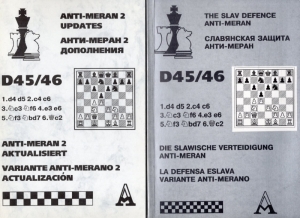 Author:
Author:
Gagarin 11.67 $ -
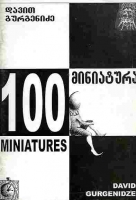 100 miniatures
Author:
100 miniatures
Author:
Gurgenidze 16.67 $ -
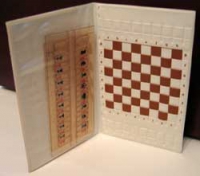 Chess pocket (Czech Republic)
45.00 $
Chess pocket (Czech Republic)
45.00 $
-
 Chess? No, chess!
Author:
Chess? No, chess!
Author:
Vlasov 19.17 $ -
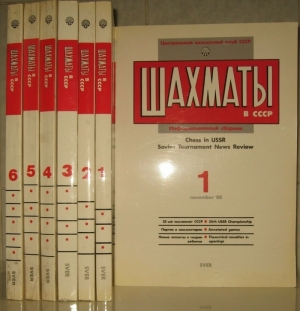 Chess in the USSR. USSR-Italy. A complete set of all seven published books
65.00 $
Chess in the USSR. USSR-Italy. A complete set of all seven published books
65.00 $
-
 Chess Mephisto 68000. Berlin
733.33 $
Chess Mephisto 68000. Berlin
733.33 $
-
 Wooden souvenir chess. THE USSR.
133.33 $
Wooden souvenir chess. THE USSR.
133.33 $
-
 Cross stitch pattern of chess
100.00 $
Cross stitch pattern of chess
100.00 $
-
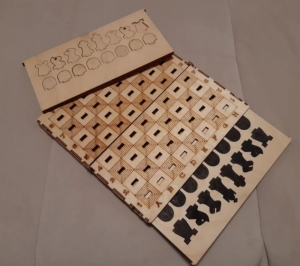 Wooden travel chess. Laser cutting.
46.67 $
Wooden travel chess. Laser cutting.
46.67 $
 Русский
Русский  Английский
Английский 